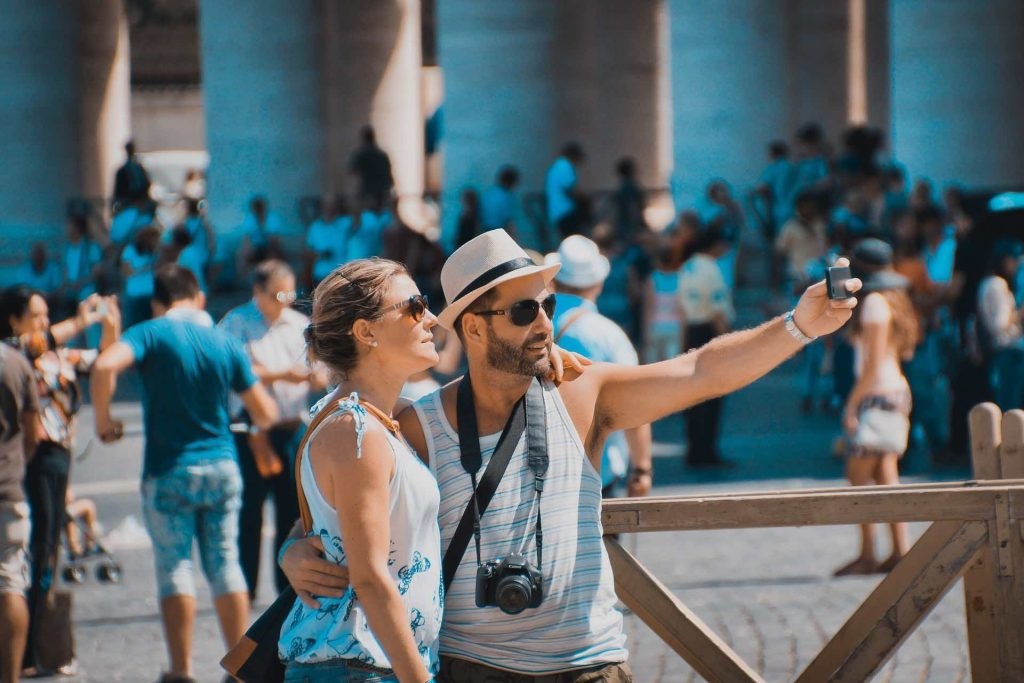I was in Barcelona last month and was privileged to see this extraordinary and eye-opening new visitor experience in the heart of Barcelona. The Torre Glòries has long been a dramatic and much-photographed building in the heart of Barcelona. It now has a viewing platform graced by a contemporary cloud sculpture, but it was the basement that took my breath away – showing me Barcelona as I have never seen a city before – I can’t wait to go back and to spend more time in the basement. The basement is a world-class attraction, if you are in Barcelona, don’t miss it – you’d best pre-book your ticket.
First, the tower, with which you may well be familiar, the viewing platform is new and the Tomás Saraceno cloud sculpture is a treat but the basement is the not-to-be missed show stopper – we’ll come to that.
Like Gaudi, Jean Nouvel was inspired by the rounded form of the Montserrat mountains to the north of Barcelona when he designed the Torre Glòries. This signature building is covered by “aluminium sheets lacquered in 26 different colours in earth, red, blue, green and grey tones, which fade the higher they go. The second is formed by 52,744 transparent and translucent panes of glass. These layers evoke shiny, smooth water, full of filtered light.”

Previously known as the Torre Agbar, inaugurated in 2005, it has long been a signature building in the city, rising to 144 metres and at the heart of the diagonals. The observation deck provides a 360° view of the city. It offers more than just an observation deck with a walk-in sculpture by Tomás Saraceno that uses the concept of clouds “to reflect on the interdependence of all living beings.”

Floating amidst the clouds of Barcelona.
All this is stunning but for me it was the basement that wowed.
You enter the new Mirador Torre Glòries through the basement of the tower which offers Hyperview Barcelona created by Media Pro Exhibitions, who design spaces to tell stories. In the basement of the Torre Glòries they present Barcolan as you will never have seen it before.: stunning, enlightening, memorable.
Created using real-time big data to create multi-media sound and visual effects, you feel the pulse of the city. Barcelona is experienced “as a living organism that beats, with rhythms and cycles where people, ecosystems, infrastructures and technologies all intertwine.” Think of James Lovelock’s Gaia Principle applied in sound and vision to Barcelona. For me the experience was transformational.
Barcelonians reminds us that as humans we share the city with a wide diversity of other species, our none human neighbours. This Hyperview of Barcelona reminds us that “All of its neighbours, human and non-human, comprise the dance of the city, a complex daily intertwinement in which pollen in the air, traffic on the streets, seagulls and palm trees, each satellite that crosses its sky and each wave that breaks on the sand, all play a role.” The 132 fine folded paper sculptures of the species by Joan Sallas are exquisite. An attraction in their own right.

Atmosferes is a seven-minute experience which explores the space in which the city sits through sky, wind, sea and sound. All are presented in real-time. The projections are generated automatically using data continuously fed from sensors around the city. You will likely want to immerse yourself for more than one seven-minute cycle in this.

Rhythms presents Barcelona as an organism. Revealing the way the air moves, the trees the lungs of the city that make the it habitable, and the flow of goods, people and data through the city. “The city’s health and that of all the living beings inhabiting it depends on the balance of this complex metropolitan metabolism. From these flows of energy, material, information and people, and in the footprints they leave behind, we can read Barcelona’s vital signs.”

Don’t miss this 21st century attraction, understand a city as you have never seen one before, and remember James Lovelock when you experience it.













